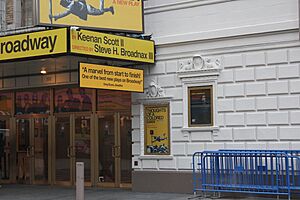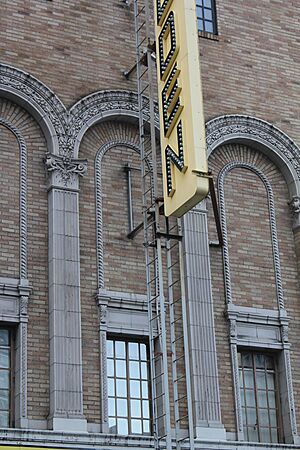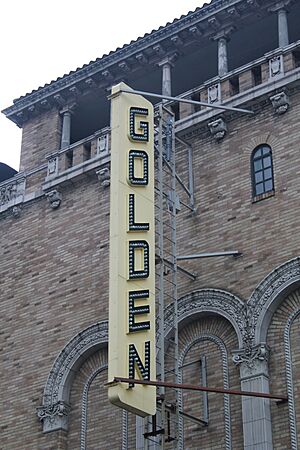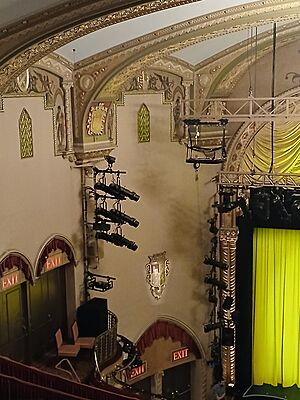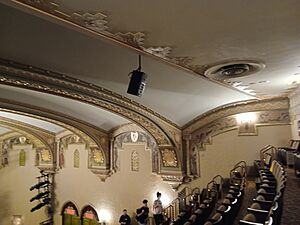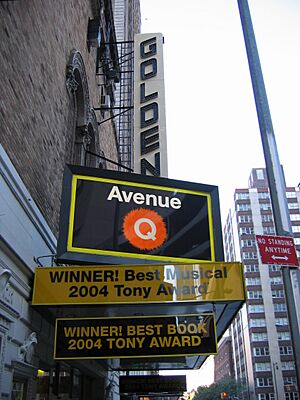John Golden Theatre facts for kids
|
Theatre Masque
|
|
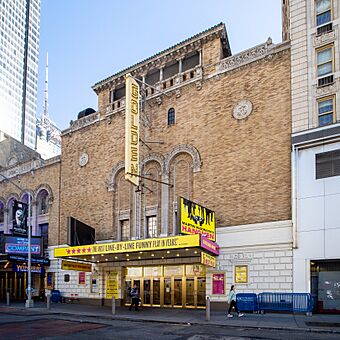 |
|
| Address | 252 West 45th Street Manhattan, New York United States |
|---|---|
| Coordinates | 40°45′31.5″N 73°59′16.6″W / 40.758750°N 73.987944°W |
| Public transit | Subway: Times Square–42nd Street/Port Authority Bus Terminal |
| Owner | The Shubert Organization |
| Type | Broadway |
| Capacity | 802 |
| Production | Operation Mincemeat |
| Construction | |
| Opened | February 24, 1927 |
| Years active | 1927–1946, 1948–present |
| Architect | Herbert J. Krapp |
| Designated | November 17, 1987 |
| Reference no. | 1335 |
| Designated entity | Facade |
| Designated | November 17, 1987 |
| Reference no. | 1336 |
| Designated entity | Auditorium interior |
The John Golden Theatre is a famous Broadway theater in New York City. It is located at 252 West 45th Street in the Theater District of Midtown Manhattan. The theater first opened in 1927. It was designed by Herbert J. Krapp in a beautiful Spanish style.
This theater was built for a real estate developer named Irwin S. Chanin. It has about 800 seats for audience members. Today, the Shubert Organization operates the theater. Both the outside (facade) and the inside (auditorium) of the theater are considered important New York City landmarks.
The outside of the theater looks like a Spanish building. It has golden bricks, special clay decorations called terracotta, and stone. The main entrance on the ground floor is covered in rough terracotta blocks. Above the entrance, there are three tall arches and two terracotta plaques. The very top of the building has an open gallery called a loggia.
Inside, the theater also has Spanish-style details. It has a large balcony and a ceiling with curved ribs. Because the theater is not very big, it does not have special "box" seats. The balcony, the stage opening (proscenium arch), and the exit arches are all beautifully decorated. They have geometric patterns and twisting small columns.
The John Golden Theatre was originally called the Theatre Masque. It was part of a bigger project by Irwin Chanin. This project included the Majestic and Royale theaters, and the Lincoln Hotel. The Masque Theatre opened on February 24, 1927. It was the second of the three theaters to open.
The Shubert family took over the Masque in 1930. Later, a producer named John Golden leased the theater in 1936. He renamed it after himself in 1937. The Shuberts got full control of the theater again in 1945. The Golden Theatre has mostly been used for live shows since then. For a short time, from 1946 to 1948, it was used as a movie theater. Over the years, the Golden Theatre has often hosted plays with small casts and musical shows called revues.
Contents
Where the Theater Is Located
The John Golden Theatre is at 252 West 45th Street. This street is also known as George Abbott Way. It is on the south side of the street, between Eighth Avenue and Seventh Avenue. This area is close to Times Square in the Theater District of Midtown Manhattan, New York City.
The theater building is rectangular. It covers about 6,400 square feet. It is 62.33 feet wide on 44th Street and 109.67 feet deep. The Golden Theatre is next to the Row NYC Hotel on its west side. It is also very close to six other theaters. These include the Bernard B. Jacobs, Gerald Schoenfeld, and Booth theaters to the east. The Broadhurst and Shubert are to the southeast. The Majestic is to the south.
This area has the largest number of Broadway theaters on one block. More people walking on 45th Street helps the theaters there sell more tickets. The Majestic, Masque (now Golden), and Royale (now Bernard B. Jacobs) theaters were all built at the same time. The land where these buildings stand used to have twenty brownstone houses. The Astor family owned this land from 1803 until 1922.
Theater Design
The Golden Theatre, originally called the Theatre Masque, was designed by Herbert J. Krapp. It was built between 1926 and 1927 for the Chanin brothers. The theater is named after the famous producer John Golden (1874–1955). It was part of a big entertainment complex. This complex included the Lincoln Hotel and the Majestic and Royale theaters. All these buildings were designed by Krapp in a Spanish style. The Masque was planned to be the smallest theater in this group, with about 800 seats. The Chanin Realty and Construction Company built all four structures. Today, the Shubert Organization operates the Golden Theatre.
Outside Look (Facade)
The front of the Golden Theatre is designed to be balanced on both sides. The ground floor is covered with rough blocks of terracotta. Below this is a granite base. At the ground level, the entrance to the theater has four sets of glass and aluminum doors. To the left of the doors, there is a modern sign board with a bronze frame. There are also two display boxes on either side of the doors. One box has spiral designs, and the other has stylized lions. A special plaque honoring John Golden is next to the doors. A large sign, called a marquee, hangs above the entrance. A decorative border (cornice) and a band run above the ground floor. The stage door is to the right of the main entrance. This door is shared with the Majestic and Bernard B. Jacobs theaters.
The upper parts of the building have gold-colored bricks. The brick design was made to match the nearby theaters and hotel. The middle of the facade has three arches that span the second and third floors. These arches have molded leaf decorations. They rest on terracotta pillars with Corinthian-style tops. On the second floor, there are metal-framed windows with many small panes. Above these windows is a horizontal rope-like molding. The arches on the third floor do not have windows. A similar, wider set of arches is on the nearby Bernard B. Jacobs Theatre.
A sign with the theater's name is in front of the middle arch. Near the top of the facade, there are terracotta medallions. These show imaginary creatures and leaf decorations. The top edge of the facade has a terracotta railing. Above the center part of the facade is a loggia, which is like an open gallery. This loggia has six single columns with decorative tops. These columns support a cornice with small decorative blocks. The loggia also has a Spanish-style roof made of tiles. The Golden's loggia matches a similar one on the stage area of the Bernard B. Jacobs Theatre.
Inside Look (Auditorium)
The Theatre Masque originally had a red and blue color scheme. It was decorated with gray, and the seats were burnt orange. The inside of the theater also has a Spanish style, just like the outside. The way the seats were arranged was part of a plan by Irwin Chanin to make the theater more "democratic." The Golden was designed with only one balcony, not the usual two. Chanin thought the second balcony was too far away from the stage. The Chanin brothers wanted each of their three theaters to look different but still have a Spanish theme. After a renovation in 2013, the theater now has orange/red and blue/green colors, similar to its original look.
The auditorium has a main floor (orchestra level), one balcony, and a stage behind the proscenium arch. The auditorium is wider than it is deep. It is decorated with plaster designs that stand out. The Shubert Organization says the auditorium has 802 seats. Other sources say 787 or 805 seats. The seats are divided into 465 on the main floor, 110 at the front of the balcony, and 227 at the back of the balcony. The Golden Theatre does not have special "box" seats. Restrooms and drinking fountains are located below the main floor. In 1927, it was noted that the theater's 800 seats were a bit wider than those in other Broadway theaters at the time.
Seating Areas
At the back of the main floor, doors from the ticket lobby lead to a walkway behind a modern wall. There are decorative exit signs above the doorways in the center of the back wall. The main floor slopes down toward the stage. The eastern wall curves inward because the Bernard B. Jacobs Theatre is right next door. The main floor and its walkway have walls with rough stucco blocks. Lighting fixtures called sconces are on the walls. Two staircases connect the main floor to the balcony. The main floor is accessible for wheelchairs, but there are no elevators to the balcony. On both sides of the front part of the main floor, there are pointed arches with two sets of doors. These doors have twisting columns next to them. Above the doors are decorative frames for the exit signs. There are also shields high on the walls above the arches. The doorways originally had red velvet curtains, which were put back during the 2013 renovation.
The balcony level is split into front and back sections by an aisle. Ornate metal railings surround the staircases in this aisle. The front part of the balcony curves forward toward the walls and has decorative metal railings. Like the main floor, the walls have lighting sconces. The walls are made of stucco blocks with low-relief Moorish designs. There are arched doorways with exit doors at the front of the balcony. Above the wall is a decorative band with geometric patterns. Panels with geometric patterns are on the front and underside of the balcony. Lights have been installed in front of the balcony.
Other Design Features
Next to the arched exits on the main floor is an oval-shaped proscenium arch. This archway has a pair of twisted columns on each side. Above these columns are smaller columns that rise to the arch's supports. A band with geometric patterns runs along the arch itself. The curved ceiling is divided into sections by arched ribs. These ribs separate the auditorium into different areas. The arches are supported by decorative brackets on each wall. Twisting small columns are next to each bracket. The ribs themselves have low-relief carvings, shields, and geometric patterns. A decorative band with geometric patterns runs just below the ceiling. At the back of the auditorium, the ceiling is flat. It has a technical booth surrounded by grilles. The distance from the back of the auditorium to the proscenium is about 24 feet 9 inches. The distance to the front of the stage is about 27 feet 5 inches.
Theater History
Times Square became the main place for big theater shows between 1900 and the Great Depression. In the early 1900s, many theaters in Midtown Manhattan were built by the Shubert brothers. They were a major group in the theater world. The Chanin brothers built another group of theaters in the mid-1920s. Even though the Chanins mostly worked in real estate, Irwin Chanin became interested in theater. He remembered feeling "humiliated" as a poor student because he had to use a separate door to buy cheap seats in the upper balcony. By October 1926, the Chanins decided to build and run theaters in New York and other big cities. Herbert Krapp had already designed other theaters for the Chanins before.
Early Years
Chanin Ownership
The Chanin brothers bought the land in May 1925. They planned to build a hotel and three theaters. In March 1926, Krapp submitted plans for the hotel and theaters. The project was expected to cost $4.5 million. News reports said there would be a large theater on 44th Street and a medium and small theater on 45th Street. The old brownstone houses on the site were torn down starting in May. By July, the Chanin brothers received a $7.5 million loan for the four buildings. Irwin Chanin held a contest asking people to suggest names for the three theaters. The names were announced in December 1926. The large theater became the Majestic. The mid-sized theater became the Royale. The small theater became the Masque. The next month, the Chanins gave A. L. Erlanger control over booking shows for the new theaters.
The Theatre Masque opened on February 24, 1927, with a play called Puppets of Passion. It was the second of the three new Chanin theaters to open. The opening of these theaters helped expand the Broadway theater district further west. Each Chanin theater had a different purpose. The 1,800-seat Majestic was for "revues and light operas." The 1,200-seat Royale was for "musical comedies." The 800-seat Masque was for "intimate" plays. The Chanin brothers were very hopeful about the Masque. It was the closest of their theaters to the new subway line. Critics liked the theater itself. However, Puppets of Passion was not popular and closed quickly.
The Masque mostly hosted plays that did not last long in its first two years. In July 1929, the Shubert brothers bought half-ownership in the Majestic, Masque, and Royale theaters for $1.8 million. The Masque's first big success was Rope's End in 1929. This play was later made into the Alfred Hitchcock film Rope. Bird in Hand also premiered at the Masque in December of that year. It later moved and ran for 500 performances.
1930s and Early 1940s
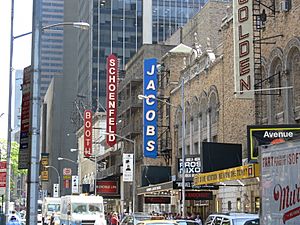
The Shuberts gained full control of the Masque in 1930. However, many shows during this decade were not successful. One early success was Broken Dishes in 1930. Another play, Up Pops the Devil, ran for 146 performances. Goodbye Again, a romance, opened in 1932 and ran for 212 performances. Tobacco Road, another play that became a hit, premiered at the Masque in 1933. Other successful plays in the mid-1930s included Post Road (1934), Laburnum Grove (1935), and Russet Mantle (1936). All of these ran for over 100 performances.
The Broadway theater business struggled during the Great Depression. The Majestic, Masque, and Royale theaters were sold in November 1936. A Shubert family representative bought the rights to operate them. The Holmeses of Baker Street was the last show at the Masque before its name changed. In late December, producer John Golden leased the Masque. He planned to fix it up and rename it after himself. The theater became the John Golden Theatre on January 26, 1937. The first show in the newly named theater was And Now Goodbye, which was not a success.
The Golden Theatre continued to host shows that closed quickly. One very short run was Curtain Call in 1937, which only had four performances. The Golden's next hit was Shadow and Substance, which opened in 1938 and ran for 206 performances. Another play, The White Steed, was also somewhat successful in 1939. A major hit opened in 1941 with Angel Street. This play ran for almost 1,300 performances over three years. Angel Street became the Golden's longest-running show at that time. It was followed in 1944 by Soldier's Wife, which ran for 255 performances.
Later Shubert Operation
Mid-1940s to 1960s
The Shubert brothers bought the Majestic, Golden, and Royale theaters in 1945. This gave them full ownership. In the mid-1940s, the Golden showed many average plays. In July 1946, the Golden was leased to Super Cinema Corporation. They planned to show Italian films. Instead, the Golden showed the British film Henry V for almost a year. The theater was used as a movie theater until February 1948. Then, Maurice Chevalier performed a solo show there. The Golden then hosted several short-run shows with live performers. In 1950, the Golden hosted a moderate hit, The Velvet Glove. Other works in the early 1950s included The Green Bay Tree and The Fourposter.
Victor Borge's one-man show Comedy in Music opened in 1953. It ran for 849 performances over three years. In contrast, Waiting for Godot in 1956 only had 59 performances. Look Back in Anger was also a minor hit in 1958. Starting in the late 1950s, the Golden hosted many shows with two performers. These included A Party with Betty Comden and Adolph Green (1958), The Billy Barnes Revue (1959), and At the Drop of a Hat (1959). An Evening With Mike Nichols and Elaine May opened in 1960 and ran for 306 performances.
The Golden hosted Sunday in New York with Robert Redford in 1962. Beyond the Fringe premiered later that year, running over 600 performances. Victor Borge returned in 1964 with his solo show. This was followed in 1966 by Wait a Minim!, which ran for 457 performances. Most other shows at the Golden in the 1960s were short-lived.
1970s and 1980s
The first success in the 1970s was Bob and Ray—The Two and Only, a comedy that ran for 158 performances. In 1972, The Public Theater presented Sticks and Bones, which ran for 245 performances. Two major shows opened in 1977. These were Dirty Linen & New-Found-Land and The Gin Game. The Gin Game won a Pulitzer Prize and ran for 517 performances.
In 1980, the Golden hosted A Day in Hollywood / A Night in the Ukraine. This show later moved, and the Golden was renovated. The theater reopened in October with Tintypes. The next year, the Golden hosted Crimes of the Heart, which won a Pulitzer Prize and ran for 535 performances. Two other Pulitzer-winning shows were then staged at the Golden: 'night, Mother in 1983 and Glengarry Glen Ross. This set a record for the number of Pulitzer-winning shows on Broadway. A revival of Blood Knot opened in 1985. This was followed by Stepping Out and All My Sons in 1987. During the 1980s, the Shuberts renovated the Golden as part of a program to restore their Broadway theaters.
The New York City Landmarks Preservation Commission (LPC) began considering protecting the John Golden Theatre as a city landmark in 1982. The LPC officially named both the outside and inside of the theater as landmarks on November 17, 1987. This was part of a larger effort to give landmark status to Broadway theaters. The Shuberts and other theater owners sued the LPC in June 1988. They wanted to overturn the landmark designations for 22 theaters, including the Golden. They argued that the designations limited how much they could change the theaters. The lawsuit went to the highest courts, but the landmark designations were upheld in 1992.
1990s to Present
In 1990, Michael Feinstein performed at the Golden. This was followed by Falsettos (1992), which had 487 performances. The comedian Jackie Mason later starred at the Golden in Politically Incorrect (1994), which ran for over 340 performances. It was followed by Master Class (1995), which ran for about 600 performances. Other successful shows included The Chairs (1998) and Side Man (1998). Mason returned in 1999 for Much Ado About Everything.
The first hit of the 2000s was Stones in His Pockets in 2001. This was followed by The Goat, or Who Is Sylvia? in 2002. In 2003, the Shuberts agreed to make their theaters more accessible for people with disabilities. The musical Avenue Q opened at the Golden on July 31, 2003. It became a huge hit and earned back its production cost within a year. By the time Avenue Q moved back off-Broadway in 2009, it had become the Golden's longest-running show with over 2,500 performances.
After that, the Golden hosted Oleanna (2009), Red (2010), and Driving Miss Daisy (2010). In 2013, the Shuberts hired Francesca Russo to renovate the Golden Theatre. Her company removed many newer changes and restored the original look. They used old pictures and details inspired by places like the Taj Mahal.
The Golden Theatre continued to host smaller shows in the mid-2010s. These included Vanya and Sonia and Masha and Spike (2013), Mothers and Sons (2014), and Skylight (2015). The theater closed on March 12, 2020, because of the COVID-19 pandemic. The play Hangmen was supposed to open then but was delayed. The Golden Theatre reopened on October 13, 2021, with Thoughts of a Colored Man. This allowed Hangmen to open in April 2022. Topdog/Underdog ran from October 2022 to January 2023. The play Prima Facie was staged from April to July 2023. It was followed by The Shark Is Broken from August to November 2023. The play Stereophonic ran from April 2024 to January 2025. The musical Operation Mincemeat began in February 2025.
Notable Productions
Here are some of the famous shows that have played at the John Golden Theatre. This list includes only Broadway shows.
| Opening year | Name |
|---|---|
| 1927 | Patience |
| 1929 | Rope's End |
| 1931 | The Venetian |
| 1931 | Louder, Please |
| 1933 | Tobacco Road |
| 1935 | Eden End |
| 1938 | Shadow and Substance |
| 1938 | Lightnin' |
| 1939 | The White Steed |
| 1941 | Angel Street |
| 1948 | Maurice Chevalier in an evening of Songs and Impressions |
| 1949 | Goodbye, My Fancy |
| 1950 | Let's Make an Opera |
| 1951 | The Green Bay Tree |
| 1951 | To Dorothy, A Son |
| 1952 | The Fourposter |
| 1953 | Comedy in Music |
| 1956 | Someone Waiting |
| 1956 | Waiting for Godot |
| 1957 | The Potting Shed |
| 1958 | Look Back in Anger |
| 1958 | Epitaph for George Dillon |
| 1958 | A Party with Betty Comden and Adolph Green |
| 1959 | Requiem for a Nun |
| 1959 | The Billy Barnes Revue |
| 1959 | At the Drop of a Hat |
| 1960 | An Evening With Mike Nichols and Elaine May |
| 1961 | An Evening with Yves Montand |
| 1962 | Sunday in New York |
| 1962 | Beyond the Fringe |
| 1966 | Wait a Minim! |
| 1967 | After the Rain |
| 1967 | Brief Lives |
| 1968 | Carry Me Back to Morningside Heights |
| 1968 | The Exercise |
| 1970 | Bob and Ray—The Two and Only |
| 1971 | You're a Good Man, Charlie Brown |
| 1972 | Sticks and Bones |
| 1975 | Hughie and Duet |
| 1975 | P. S. Your Cat Is Dead! |
| 1975 | Kennedy's Children |
| 1976 | Going Up |
| 1977 | Dirty Linen & New-Found-Land |
| 1977 | The Gin Game |
| 1979 | Murder at the Howard Johnson's |
| 1980 | Watch on the Rhine |
| 1980 | A Day in Hollywood / A Night in the Ukraine |
| 1980 | Tintypes |
| 1981 | Crimes of the Heart |
| 1983 | 'night, Mother |
| 1984 | Glengarry Glen Ross |
| 1985 | Blood Knot |
| 1987 | Stepping Out |
| 1987 | All My Sons |
| 1988 | Juno and the Paycock |
| 1989 | Eastern Standard |
| 1992 | Falsettos |
| 1995 | Master Class |
| 1998 | The Chairs |
| 1998 | Side Man |
| 2001 | Stones in His Pockets |
| 2002 | The Goat, or Who is Sylvia? |
| 2003 | Vincent in Brixton |
| 2003 | Avenue Q |
| 2009 | Oleanna |
| 2010 | Red |
| 2010 | Driving Miss Daisy |
| 2011 | The Normal Heart |
| 2011 | Seminar |
| 2013 | Vanya and Sonia and Masha and Spike |
| 2013 | A Time to Kill |
| 2014 | Mothers and Sons |
| 2014 | A Delicate Balance |
| 2015 | Skylight |
| 2015 | The Gin Game |
| 2016 | Eclipsed |
| 2017 | A Doll's House, Part 2 |
| 2018 | Three Tall Women |
| 2018 | The Waverly Gallery |
| 2019 | Hillary and Clinton |
| 2019 | Slave Play |
| 2021 | Thoughts of a Colored Man |
| 2022 | Hangmen |
| 2022 | Topdog/Underdog |
| 2023 | Prima Facie |
| 2023 | The Shark Is Broken |
| 2024 | Stereophonic |
| 2025 | Operation Mincemeat |
See Also
- List of Broadway theatres
- List of New York City Designated Landmarks in Manhattan from 14th to 59th Streets


